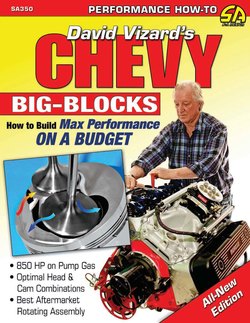Читать книгу Chevy Big Blocks - David Vizard - Страница 10
На сайте Литреса книга снята с продажи.
ОглавлениеCHAPTER 3
LUBRICATION SYSTEMS
In a Chevy big-block, it’s essential to maintain not just oil pressure but also oil control. Controlling where the oil goes in the engine can be an issue even for a nearly stock engine turning moderate RPM. When the RPM climbs, this situation really demands attention.
What is done in the lube department on an all-out race engine can amount to 50 and possibly as much as 90 hp. The potential gain for a street engine taking care of business, even with mostly stock parts, is as much as 25 hp.
Oil Pump
The first thing you need to deal with is oil pump selection. With a stock or even a pretty healthy modified unit, there is nothing to panic about as far as retaining reliability while utilizing a stock or nearly stock oil pump. However, that does not mean that there is no work to be done.
Fig. 3.1. This Moroso billet pump went on a 632-ci build equipped with Scat crank and rods and CP pistons. All this equipment was fitted to a tall-deck Dart block with Dart heads and intake. These top-quality parts are valued at a much higher level than stock, so the Moroso pump is cheap insurance for the investment.
The stock oil pump gets the job done on any engine that is good for 600 to 650 hp and 6,800 to 7,000 rpm. All you need to concern yourself with is that you bought a good stock pump and not a cheap offshore-produced item made to questionable tolerances. If the stock pump gets the job done, why consider alternative and most likely more expensive pumps? Although there are numerous answers to this question, the most obvious is that the more money you have in the engine build, the more sense it makes to better protect that investment. A number of oil pumps are available that provide both improved reliability and additional power.
Although it may come as a surprise to some, a Chevy big-block’s oil pump can draw well over 10 hp at 7,000 crankshaft rpm. Use a grade or so thicker in viscosity and that can go up another 5 hp. On the other hand, pay attention to the system’s efficiency and you can divert as much as 10 hp from what the oil pump absorbs and put that to good use at the rear wheels of your vehicle.
Wet- versus Dry-Sump Systems
If it is a question of which is best, a wet sump or a dry sump, dry is the way to go. Dry-sump systems provide better lubrication for max-performance applications. One of my favorite builds, done for a Lola T165 Can-Am car, was a dry-sump engine. But at the end of the day, I have to admit it was far from a budget unit and is out of the scope of this book.
Because I am covering budget engine builds, I am not going to discuss dry-sump systems in great detail. If you want to build a dry-sump engine, give the guys at Moroso or Reher-Morrison a call; either company has all the parts needed and all the instructions necessary for you to build one onto your big-block.
Standard- versus High-Volume Wet-Sump Pumps
